How to Care for Your Braces
Caring for braces is pretty easy if you follow a few guidelines:
Caring for braces is pretty easy if you follow a few guidelines:

The first thing to consider when cleaning your teeth is that there are three surfaces of each tooth that need to be brushed. These surfaces are:
The outside
The inside
The chewing side
When brushing the outside of your teeth you should try to make a 45 degree angle toward the gum line between the head of your toothbrush and the tooth itself.
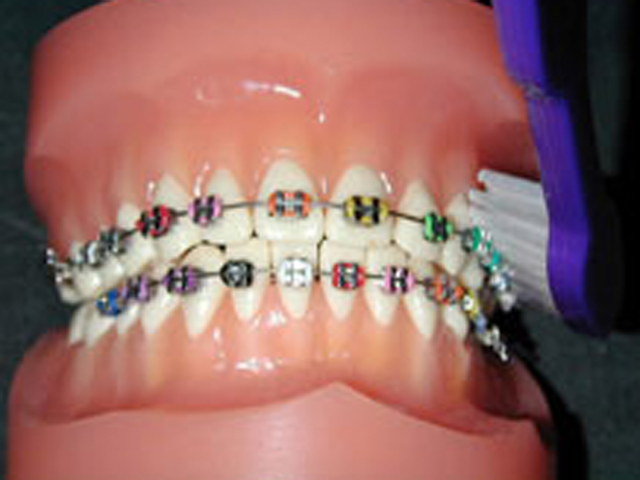
It is especially important to make sure the area between the brace and the gum stays clean.
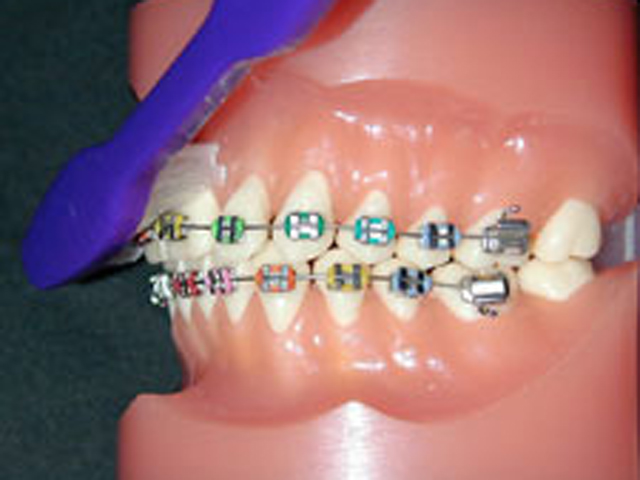
Try to focus on a few teeth at a time. Make sure these teeth are completely free of food and plaque before moving to the next few. Once you're done with the outsides of the top and bottom teeth you can move to the insides.
When brushing the inside surfaces of your teeth try to maintain the 45 degree angle towards the gum line as you did with the outside surfaces. Again, focus on just a few teeth at a time and make sure that they are clean before moving on.
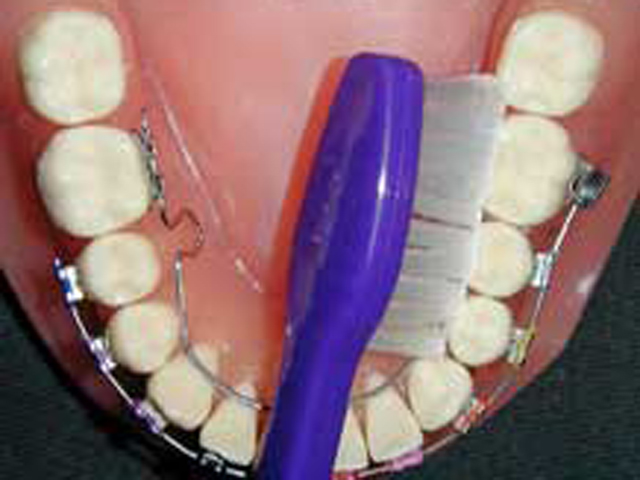
Cleaning the chewing sides of the teeth should be straight forward. Remember to focus on a few teeth at a time prior to moving on to the next ones.

Flossing with braces takes a few minutes to master, but the effort is well worth it. There of different types of ways to floss your teeth. The easiest is with a Waterpik Water Flosser, another way is with Superfloss. Oral-B makes it and it can be found in the dental aisle of most supermarkets and drug stores. The nice thing about Superfloss is that one end is stiff so threading it under the braces is easy. The other end is fuzzy and really helps to get around all surfaces of the braces. The first step to flossing is getting the floss under the wire that connects the braces together.
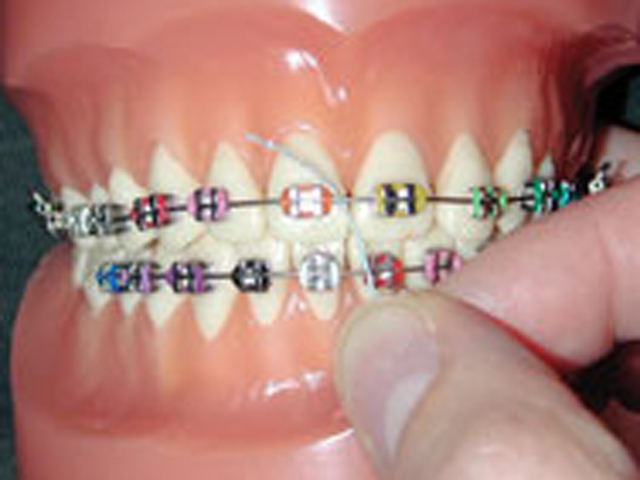
Once the floss is under the archwire it can be wrapped around the tooth on one side. The floss is then pushed up toward the gum line and then pulled down toward the wire. This should be repeated four to five times to ensure all plaque is removed. Be careful not to put too much pressure on the wire as you pull down. Then wrap the floss around the neighboring tooth. Once both teeth are done, the floss is pulled out and the process repeated for the next two teeth.
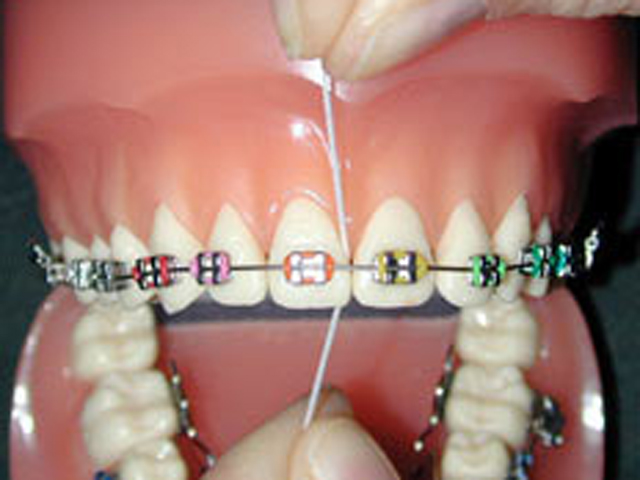

When Doctor Getchell puts on your braces he uses a bonding material that is strong enough to keep them on, but weak enough to be removed easily when your teeth are straight. Because the braces are not indestructible there are foods that need to be avoided. Hard foods may do damage by breaking the braces off of your teeth and bending the wires that are carefully designed to straighten your bite. Sticky foods may loosen your ties or get caught in the braces. Foods to avoid include:
Ice (even if you're careful)
Taffy and caramels
Jolly Ranchers and other hard candies
Gum of any kind
Hard chips like Doritos
Raw carrots, apples, pears, etc. should be cut into small pieces
Stay away from the bottom of the popcorn bowl - the hard kernels are bad news
Meat should not be chewed off of the bone, it should be cut off
Corn on the cob should be sliced off
Pizza crust, bagels, and French bread should be broken into bite size pieces
Don't chew on pens, pencils, or fingernails as they will also damage the braces
When patients take care of their braces things progress well. Many times our most conscientious patients finish their treatment ahead of schedule!

While true orthodontic emergencies are rare, occasionally a minor problem can pop up. What follows is a list of problems that may be encountered and the remedies for them.
If a spacer falls out it can be replaced very easily. The first step is to thread a piece of dental floss through the center of the spacer.
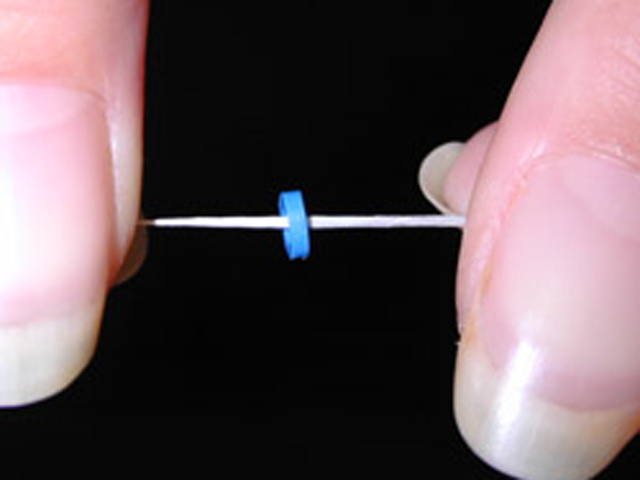
The next step is to double the floss back on itself. Repeat this with one more piece of floss. Hold one piece of floss on either side of the spacer.
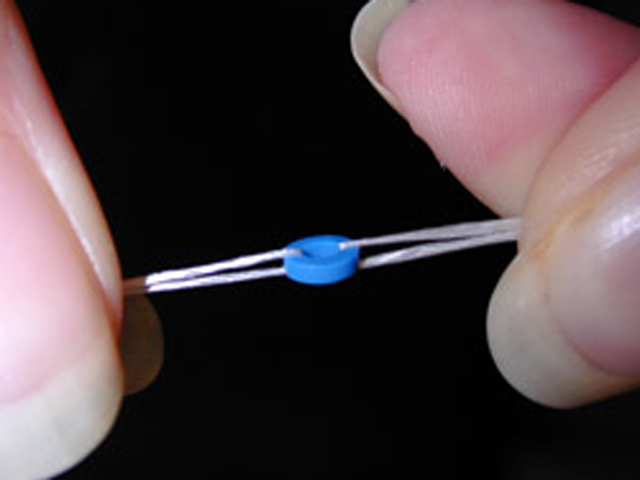
Slide the floss between the teeth where the spacer has come out.
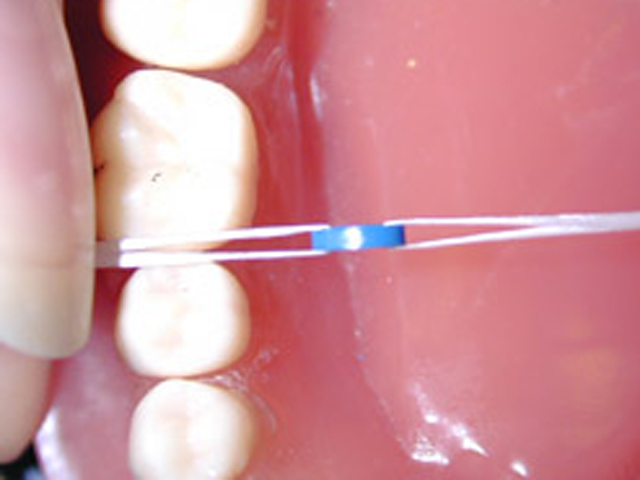
Pull the spacer through the contact.
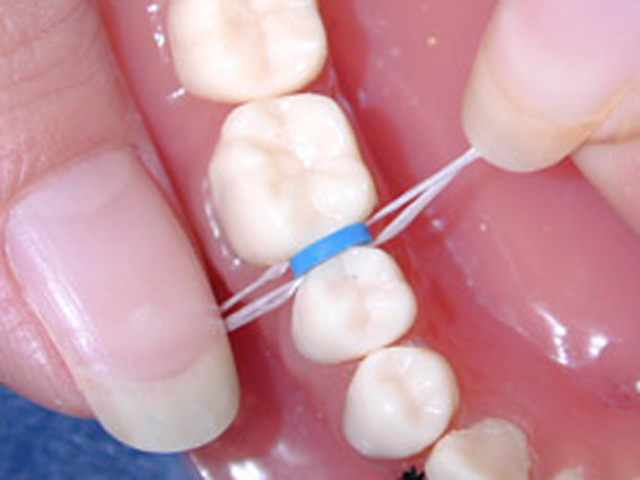
Keep a finger on top of the newly placed spacer. Gently pull one end of a doubled back piece of floss out of the mouth. Repeat with the other side.
After the initial placement of braces or following an adjustment, the teeth may be tender for a couple of days. This occasionally happens and will pass. An over the counter pain reliever such as Advil or Tylenol may be helpful in alleviating this initial soreness.
Occasionally one may notice mild tooth mobility. This is normal and makes sense when one realizes that as a tooth moves the bone around it becomes softer. After the tooth has moved to its correct position the bone around it recalcifies and becomes hard again.
Early on in treatment as the teeth move, it is possible for the wire to protrude from the back brace. This problem can be solved by taking a nail clipper and snipping the wire as close as possible to the brace. If you cannot clip the wire, placing some wax on it will help to keep you comfortable.
Just as a wire may protrude from a brace early on in treatment it is possible for a wire to come out of a brace. The solution to this problem is to simply reinsert the wire in the brace using a pair of tweezers or a needle nose plier.
If a brace breaks off of a tooth it can be left there if it is not uncomfortable to you. The most common cause of a broken brace is eating foods that are too hard or too sticky. Chewing on pens, pencils, or fingernails may also cause a broken brace. Regardless of how the brace broke please call our office during business hours to schedule an appointment to have the it repaired.
Eating hard or sticky foods can cause a wire to break. If this happens take a pair of nail clippers and cut the wire as close as possible to the next brace it is attached to.
If a tie comes off of a brace all should be fine. Often times it can be replaced with a pair of tweezers. If this is not possible please call our office so we can set up a time for you to run in and have it replaced.
If an expander becomes loose we do not want you to activate it until you are seen. Usually the expander can be pushed back onto the tooth until you can get back into our office. Sticky foods are usually the cause of this.
Sometimes to secure the brace to the wire we twist a very small stainless steel ligature around it. Infrequently it is possible for the twisted end of the ligature to move and start to feel sharp. If this happens simply use a pencil eraser to gently push it into a comfortable position.
Doctor Getchell may be reached by our patients after business hours in the case of an orthodontic emergency. We are here to not only give you a great smile, but also to keep you comfortable!
